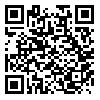BibTeX | RIS | EndNote | Medlars | ProCite | Reference Manager | RefWorks
Send citation to:
URL: http://jstnar.iut.ac.ir/article-1-790-en.html
Application of meteorological indicators has extensive use in drought monitoring. However, hydrological indicators can also play an effective role in this task. In this research, one of the rare approaches in drought monitoring with hydrological indicators namely Chang method has been applied and assessed for the Tehran basin using daily time step. The results have been compared with the unique meteorological drought index, EDI (effective drought index) and show the capabilities of the hydrological method and its more sensivity to water resources deficit. For instance, application of these procedures for the 1998 to 2000 drought spell in Tehran province revealed that Change method declares 31.1 % of times in very severe drought whereas it is 3.7 in EDI. Because of applying different indicators (e.g. reservoir and ground storage), a combination of both procedures is an ideal approach for drought monitoring in which the water inputs to the system as well as storage and consumptions are considered. The applied methodology makes it Possible to distinguish droughts due to rainfall deficit from the ones, which are resulted from water resources miss management.
| Rights and permissions | |
 |
This work is licensed under a Creative Commons Attribution-NonCommercial 4.0 International License. |





